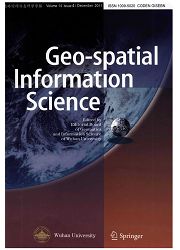Detecting vehicle traffic patterns in urban environments using taxi trajectory intersection points
作者:Andreas Keler,Jukka M.Krisp,Linfang Ding
摘要:Detecting and describing movement of vehicles in established transportation infrastructures is an important task.It helps to predict periodical traffic patterns for optimizing traffic regulations and extending the functions of established transportation infrastructures.The detection of traffic patterns consists not only of analyses of arrangement patterns of multiple vehicle trajectories,but also of the inspection of the embedded geographical context.In this paper,we introduce a method for intersecting vehicle trajectories and extracting their intersection points for selected rush hours in urban environments.Those vehicle trajectory intersection points (TIP) are frequently visited locations within urban road networks and are subsequently formed into density-connected clusters,which are then represented as polygons.For representing temporal variations of the created polygons,we enrich these with vehicle trajectories of other times of the day and additional road network information.In a case study,we test our approach on massive taxi Floating Car Data (FCD) from Shanghai and road network data from the OpenStreetMap (OSM) project.The first test results show strong correlations with periodical traffic events in Shanghai.Based on these results,we reason out the usefulness of polygons representing frequently visited locations for analyses in urban planning and traffic engineering.
发文机构:Institute of Geography
关键词:FLOATINGCarData(FCD)movingobjectstransportationinfrastructureSPATIO-TEMPORALPATTERNSFloating Car Data (FCD)moving objectstransportation infrastructurespatio-temporal patterns
分类号: R73[医药卫生—肿瘤][医药卫生—临床医学]
- Retrieval of Brown Carbon based on the aerosol complex refractive indices in the winter of Wuhan
- Remote Sensing and GIS Application in the Detection of Environmental Degradation Indicators
- High-resolution Hyper-spectral Image Classification with Parts-based Feature and Morphology Profile in Urban Area
- Building 3D Cadastral System Based on 2D Survey Plans with SketchUp
- Skyline-Based Registration of 3D Laser Scans
- Atmospheric Excitation of Polar Motion
- Design and Implementation of 3D Model Database for General-Purpose 3D GIS
- Modeling and Sensitivity Analysis of Navigation Parameter Errors for Airborne Synthetic Aperture Radar Stereo Geolocation
- Integrating Terrain and Vegetation Indices for Identifying Potential Soil Erosion Risk Area
- Doppler Properties of Spaceborne/Airborne Hybrid Bistatic Synthetic Aperture Radar


